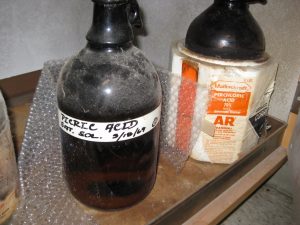Once upon a time, the radiation safety officer (RSO), let’s call him Bob, had been out performing the inventory of source material* and ran across a bit of excitement.
In this particular lab, they had approximately 10 grams of uranyl acetate, a very common contrast stain for electron microscopes. The poor unfortunate grad student who was trying to wrangle things for the RSO presented the uranyl acetate to Bob for him weigh and verify, but Bob ignored him. Bob was looking over the grad student’s shoulder at the fume hood behind him. Bob took a picture of it for us all to enjoy later, evacuated the lab, and told the grad student to get the department chair down here RIGHT NOW while Bob called the chemical safety folks to come up and help.

Flash forward to the staff meeting as Bob presents his pictures. I may have let out a pained yelp of terror when this one came up on the screen. I apologize for the lack of detail for this picture, but the brown bottle has a handwritten label that reads “PICRIC ACID, SAT. SOL., 3/18/69, *happy face*”
Bob: “So, does anyone see any problems with this picture?”
Me: “YES! There’s a four fucking liter bottle of picric acid!”
Bob: “Note that the bottle says ‘Sat. Sol.’ How would we know if it weren’t safe?”
Me: “Well, I suppose if it wasn’t safe they would’ve labeled it with a frowny face instead of a happy one.”
Bob: [gives me a glare] “Right, no more four day weekends for you. You get sarcastic if we give you too much time off. I was referring to the crystalline sediment in the bottom of the bottle that shows this is clearly a supersaturated solution now.”
Me: [emits another yelp of terror]
Co-Worker 1: “Jeez, they haven’t cleaned their lab in 40 years if that’s been lying around since it got labeled.”
Co-Worker 2: “No…the building they’re in now has only existed for 17 years. They had to move it here from somewhere else first…*trails off into contemplative horror*“
Supersaturated picric acid is a shock & light sensitive bomb, similar to unstable crystallized ether. There have been an awful lot of lab explosions over the decades due to forgotten picric bottles which is why it is pretty much banned in anything other than microquantities. A 4L bottle is a job that even the bomb squad is reluctant to touch.
As a nice bonus, if you look closely you’ll notice that there’s a bottle of 70% percholoric acid next to it, which is another potential bomb. At the very least, a POWERFUL oxidizer to help promote the coming firestorm when everything goes sideways.
The happy ending is that everything worked out nicely and nothing had to be detonated with a sniper rifle from a safe distance. This time.
* Source material is defined as naturally occurring or depleted uranium or thorium materials which could, potentially, be refined and enriched. In practice, this normally translates to “anything we feel like nailing you for not having on your inventory already” as this is stuff any member of the public can buy, but as license holder you have a responsibility to keep track of it.